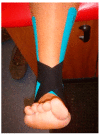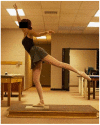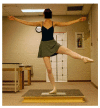Effect of Kinesio® Taping on Ankle Complex Motion and Stiffness and Jump Landing Time to Stabilization in Female Ballet Dancers
- PMID: 33467334
- PMCID: PMC7739296
- DOI: 10.3390/jfmk4020019
Effect of Kinesio® Taping on Ankle Complex Motion and Stiffness and Jump Landing Time to Stabilization in Female Ballet Dancers
Abstract
Ankle sprain is the most commonly diagnosed injury experienced by ballet dancers with few studies investigating preventive support measures such as Kinesio taping. The need exists to examine the mechanical support characteristics of Kinesio taping and effect of application on ankle motion and performance. This may be important to understanding the mechanical mechanisms attributed to Kinesio ankle taping and justify its use in the prevention and treatment of jump landing injuries in ballet dancers. This study compared Kinesio taping with and without tension and no tape (control) on active and passive measures of ankle complex motion in healthy ballet dancers. A secondary objective was to examine the effect of Kinesio taping on balance using time to stabilization. Participants performed three ballet jumps with single-leg landings on a force plate across three ankle support conditions consisting of Kinesio taping, sham-Kinesio taping, and no tape. Sagittal and frontal plane motion and load-displacement of the ankle complex for each support condition were obtained using an ankle arthrometer. Kinesio taping with tension significantly restricted inversion-eversion rotation and increased inversion stiffness of the ankle complex (p < 0.05). No significant differences were found among the three ankle support conditions for jump landing time to stabilization (p > 0.05). Arthrometric results indicate Kinesio taping significantly restricted ankle complex motion in the frontal plane that is associated with lateral ankle sprain. Objective information on the nature of Kinesio taping support can assist sports medicine practitioners when recommending ankle support to athletes.
Keywords: Kinesio tape; ankle arthrometry; ankle sprain; ballet dancers; time to stabilization.
Conflict of interest statement
The authors declare no conflict of interest.
Figures









Similar articles
-
Effect of Mulligan's and Kinesio knee taping on adolescent ballet dancers knee and hip biomechanics during landing.Scand J Med Sci Sports. 2015 Dec;25(6):888-96. doi: 10.1111/sms.12302. Epub 2014 Aug 5. Scand J Med Sci Sports. 2015. PMID: 25091570
-
Kinesio taping is superior to other taping methods in ankle functional performance improvement: a systematic review and meta-analysis.Clin Rehabil. 2018 Nov;32(11):1472-1481. doi: 10.1177/0269215518780443. Epub 2018 Jul 18. Clin Rehabil. 2018. PMID: 30020820
-
Effect of ankle kinesio taping on vertical jump with run-up and countermovement jump in athletes with ankle functional instability.J Phys Ther Sci. 2015 Jul;27(7):2087-90. doi: 10.1589/jpts.27.2087. Epub 2015 Jul 22. J Phys Ther Sci. 2015. PMID: 26311931 Free PMC article.
-
Kinesio taping does not improve ankle functional or performance in people with or without ankle injuries: Systematic review and meta-analysis.Clin Rehabil. 2021 Feb;35(2):182-199. doi: 10.1177/0269215520963846. Epub 2020 Oct 20. Clin Rehabil. 2021. PMID: 33081510
-
Acute Effect of Ankle Kinesio and Athletic Taping on Ankle Range of Motion During Various Agility Tests in Athletes With Chronic Ankle Sprain.J Sport Rehabil. 2019 Oct 18;29(5):527-532. doi: 10.1123/jsr.2018-0398. Print 2020 Jul 1. J Sport Rehabil. 2019. PMID: 31034326
Cited by
-
Risk Factors of Ankle Sprain in Soccer Players: A Systematic Review and Meta-Analysis.Sports (Basel). 2025 Mar 28;13(4):105. doi: 10.3390/sports13040105. Sports (Basel). 2025. PMID: 40278731 Free PMC article. Review.
-
In Patients with Grade I and II Ankle Sprains, Dynamic Taping Seems to Be Helpful during Certain Tasks, Exercises and Tests in Selected Phases of the Rehabilitation Process: A Preliminary Report.Int J Environ Res Public Health. 2022 Apr 27;19(9):5291. doi: 10.3390/ijerph19095291. Int J Environ Res Public Health. 2022. PMID: 35564686 Free PMC article.
-
Prevalence of musculoskeletal injuries among university undergraduates following Sri Lankan traditional dancing.PLoS One. 2023 Aug 10;18(8):e0288155. doi: 10.1371/journal.pone.0288155. eCollection 2023. PLoS One. 2023. PMID: 37561754 Free PMC article.
-
Prophylactic ankle supports effects on time to stabilization, perceived stability and ground reaction force during lateral landing in female collegiate athletes with chronic ankle instability.BMC Sports Sci Med Rehabil. 2021 Jun 3;13(1):62. doi: 10.1186/s13102-021-00291-3. BMC Sports Sci Med Rehabil. 2021. PMID: 34082825 Free PMC article.
-
Effects of ankle Kinesio taping on knee and ankle joint biomechanics during unanticipated jumps in collegiate athletes.PLoS One. 2024 Aug 1;19(8):e0305480. doi: 10.1371/journal.pone.0305480. eCollection 2024. PLoS One. 2024. PMID: 39088514 Free PMC article.
References
-
- Ahonen J. Biomechanics of the foot in dance: A literature review. J. Dance Med. Sci. 2008;12:99–108. - PubMed
LinkOut - more resources
Full Text Sources

